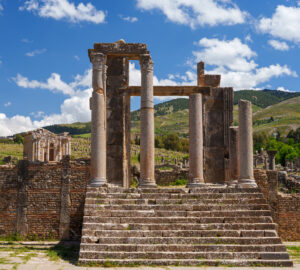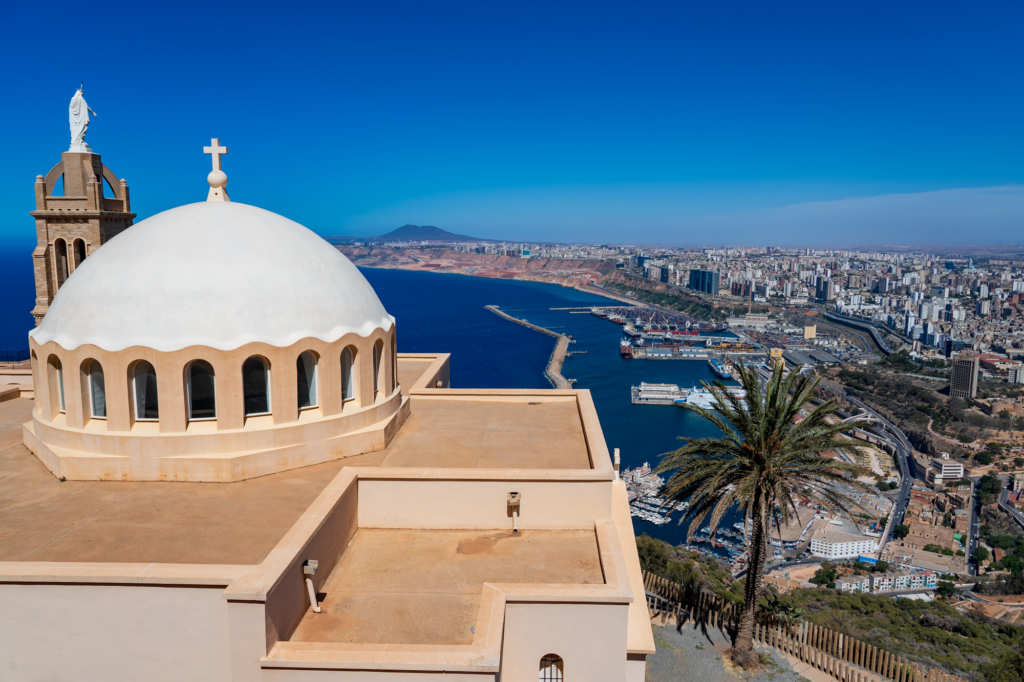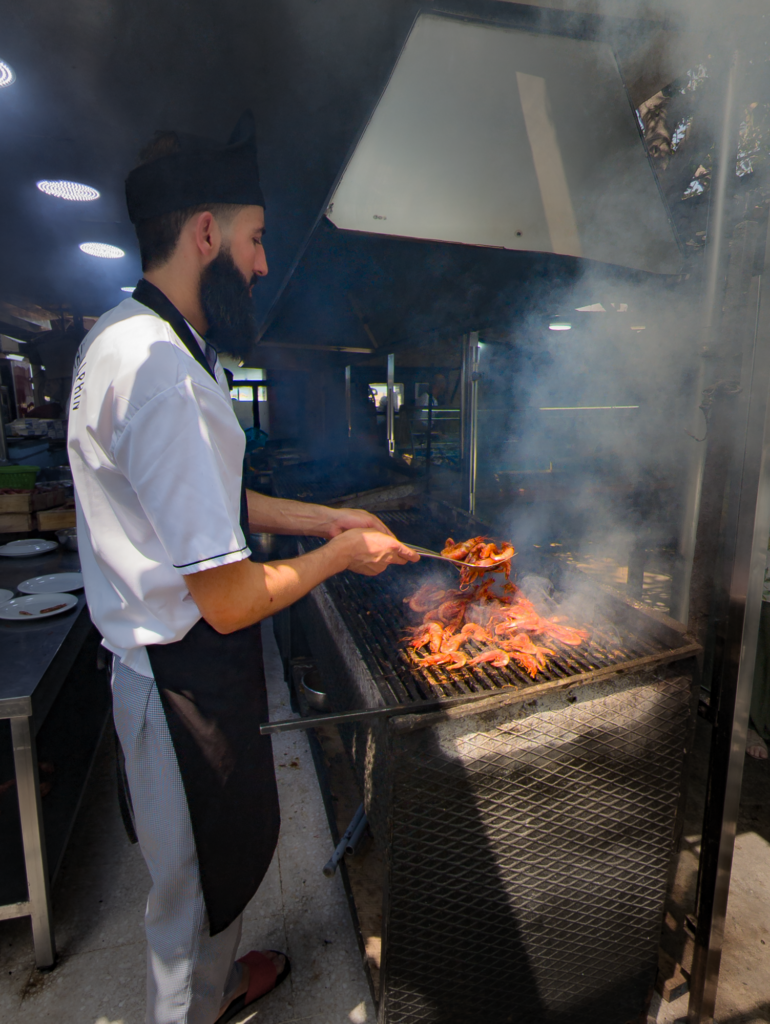A Bumpy Start, a Smooth Landing in Algiers
The excitement of our Algerian adventure was almost derailed before it began! A cancelled flight from London meant a frantic scramble, rebooking for the following day. But a day of unplanned exploration in London turned out to be a delightful bonus. Finally, we touched down in Algiers, our hotel perched high above the bay offering a stunning reward after a rocky start to the trip.
Djémila: Roman Grandeur, Local Delights, and Scenic Drives
Our journey began eastwards, arriving in Djémila at lunchtime. Before exploring we sat down for a tantalizing taste of Algerian cuisine – lentil soup, rumoured to be some of the best we’d ever try, followed by chicken with couscous and fresh vegetables. With full bellies it was time to explore Djémila, a UNESCO World Heritage Site boasting a remarkably well-preserved Roman settlement.
Known under its antique name, Cuicul, it was established in 96-98 CE. We wandered past the ruins of a senate, forum, temples, and a marketplace, each whispering tales of a glorious past. As the city expanded it added a market, basilica, and the Arch of Caracalla. Further development added a Christian church and baptistry. Intricate mosaics, crafted with the finest detail and displayed in the nearby museum, stunned us, and transported us back in time. Depicting the life of Bacchus, the kidnap of Europa by Jupiter, and various hunting scenes, most were still largely complete. Between the ruins and museum we spent a good couple of hours marvelling at the sheer completeness of this ancient site.

Mosaics, Djemila 
Roman Ruins, Djemila
Constantine: City of Bridges and Panoramic Thrills (and Chills!)
Constantine, perched precariously on a rocky pinnacle, earned its nickname – the City of Bridges. These bridges, however, tested my limits. More on that in a minute!
The morning offered a chance to explore the nearby ruins of Tiddis, originally built by the Romans as a defensive castle. Though much smaller than Djémila, it offered stunning views out over the surrounding landscape from its hilltop location.
As we made our way back into the city, my fear of heights came into play as we crossed the Mellah Slimane Bridge, a narrow, high-up structure and ultimately I had to catch a taxi round to the other side for lunch. Later, the panoramic views from the Monument aux Morts were breathtaking, but another bridge crossing awaited. Thanks to my friend’s assistance and a strategic walk down the middle of the road (with a few heart-stopping car encounters!), I managed to conquer my anxieties and reach the other side – another minor victory over my acrophobia!
Finally it was off to Constantine airport to fly back to Algiers for the early morning flight into the Sahara the next day.
Desert Delights: Sunsets and Sand Vipers

Timimou, the “Red Oasis,” awaited us next. The scorching Saharan sun demanded a siesta in the cool comfort of our government-run hotel (though it had definitely seen better days). A delicious home-cooked lunch at a local guesthouse refueled us for an afternoon adventure. As the sun began its descent, casting long shadows across the sand dunes, our Tuareg guides led us to a vantage point to watch the sunset. Unfortunately, the dust in the air muted the fiery spectacle somewhat. The desert, however, wasn’t finished surprising us. On the drive back, we encountered a slithering Sand Viper, its sidewinding motion a stark contrast to the stillness of the dunes. A healthy dose of respect kept us at a safe distance from this venomous creature!
Back within the red walled city of Timimoun we again headed to the guesthouse for an amazing dinner before heading back to the hotel.
The next day we explored the local area, visiting some of the sand-worn Ksars – defensive castles, now long abandoned. It was also interesting to see the old water system and how the flow of water was managed and shared based on the amount of land you needed to irrigate.
From Sand Dunes to Beni Abbés’ Hot and Sandy Welcome

The next day’s journey to Taghit was the longest yet, stretching over 500 kilometres. Our air-conditioned minibus was a welcome respite from the relentless sun and temperatures which were now around 43C. Our planned picnic lunch stop in Beni Abbés, however, coincided with the day’s peak heat and strong winds, putting the sand in sandwich!
Thankfully, we didn’t linger and headed off for a quick visit to the Hermitage of Charles de Foucauld. He was a Cavalry Officer in the French army and was ordained a priest in 1901, deciding to settle in Beni Abbés. He lived with the Berbers, studying Tuareg culture and publishing the first Tuareg-French dictionary. He was assassinated at the door of the small chapel he built and recently canonized. His works are a reference for the knowledge of Tuareg culture.
After the respite of the cool shadowy chapel, it was back into the air-conditioned comfort of the bus and another few hours drive to Taghit.
Taghit: A Town Steeped in History
Taghit, a small town bordered by massive sand dunes, offered a stark contrast to the previous night’s government accommodation. This hotel, part of the same chain, seemed to have received a complete makeover. Everything functioned flawlessly, and the service was impeccable. We explored the town before dinner, capturing photos of the dunes and soaking in the local atmosphere, the call to prayer echoing through the air as the sun dipped below the horizon.

Dunes tower above Taghit 
Taghit views
From Industrial Bechar to Oran’s Spanish Flair
A somewhat disappointing breakfast couldn’t dampen our spirits as we embarked on a journey through time. Our destination: ancient rock carvings estimated to be 5,000 to 10,000 years old. Sadly, the passage of time wasn’t kind to these precious pieces of history – many were defaced by modern graffiti. A sombre note, but a reminder of the importance of preserving these cultural treasures.
Refueled with sandwiches for yet another flight later, we continued our journey to Bechar, a large industrial city. The airport check-in process offered a glimpse into Algerian informality. Our passports vanished into the hands of a random policeman, only to reappear 30 minutes later. Boarding our small propeller plane, a sense of adventure filled the air. Free seating meant a scramble for the best views as we soared above the vast desert landscape, heading back north to the coast, Oran our destination in a mere two hours.
Oran, a coastal city with a fascinating past, greeted us with a refreshing change – cooler temperatures and a welcome dose of humidity. Our first stop was a scenic viewpoint overlooking the city, bathed in the warm glow of the early evening light. Dinner that night was a delightful surprise – a delicious paella, a testament to Oran’s Spanish influences. Algeria’s colonial past had left its mark on this vibrant city.
A Walking Tour Through Oran’s Rich Tapestry

The next day was dedicated to exploring Oran’s rich history. We began at Place 1st November 1954, a bustling square adorned with the grand town hall and the ornate Abdelkader Alloula regional theatre. A short stroll away stood a former synagogue, now the Abdullah bin Salem Mosque, a symbol of Oran’s religious diversity.
Further along, we encountered the beautiful Church of the Sacred Heart, now a library and haven for students seeking a quiet place to study. The main post office, with its original safe – a silent witness to a daring 1949 robbery – offered a glimpse into Oran’s revolutionary past.
The afternoon was dedicated to Oran’s historical sites. The Red Tower at Chateau Neuf and the Bey Palace, though weathered by time, hinted at their former grandeur. We then ascended the hill once again, this time exploring the imposing Fort Santa Cruz, its thick walls keeping their secrets of past battles.
Our penultimate stop was the Oran train station, a masterpiece of neo-Moorish design. The clock tower, shaped like a minaret, and the intricate tilework inside transported us to another era. Finally, with the Oran seafront beckoning, we indulged in a refreshing ice cream – a perfect end to a day filled with history and architectural wonders.
Roman Ruins and Royal Mausoleums: A Journey Back in Time

Leaving Oran behind, we embarked on a journey eastward, stopping at the coastal town of Tipaza for lunch. Fresh prawns and grilled fish at Restaurant Le Dauphin fuelled us for our next adventure – the Roman ruins of Tipaza. Nestled amidst woods and overlooking the sparkling blue sea, these ruins, though not as extensive as Djémila, offered a picturesque glimpse into Roman Algeria.
The amphitheatre, theatre, houses, and industrial buildings whispered stories of a bygone era. One intriguing discovery was a building believed to have been used for making fermented fish paste, a possible forerunner of the now-popular Thai fish sauce!
Our final stop before returning to Algiers was the Royal Mausoleum of Mauritania, a majestic circular structure perched high above Tipaza. Although the roof was damaged by time, the mausoleum itself remained in relatively good condition. Even though it remained empty, its imposing presence offered a powerful connection to the region’s long history.
Algiers: Bustling Casbah, Seafront Serenity, and a Farewell
Our last day in Algeria began with a walk through the bustling Algiers casbah, a maze of narrow streets adorned with revolutionary graffiti. The sight of the 18th century Dey Mustapha Pacha palace teeming with tourists, both local and foreign, brought us back to the present after days exploring historical sites.
After a satisfying lunch near the port, we ventured underground, taking the metro to see the Grand Post Office, constructed in 1910 in the Moorish style and now a museum. Back on the bus, we ascended the hill to the Martyrs’ Monument, a towering structure representing three palm fronds covering an eternal flame and commemorating Algeria’s independence. A visit to the museum below and a final round of photos from the viewpoint concluded our exploration of Algiers.
The next day, bidding farewell to the scorching desert heat, Algiers’ crowds and Oran’s cool coastal breezes, Algeria had captivated us with its friendly people, delicious cuisine, and the stark contrast between its coastal cities and desert communities.

